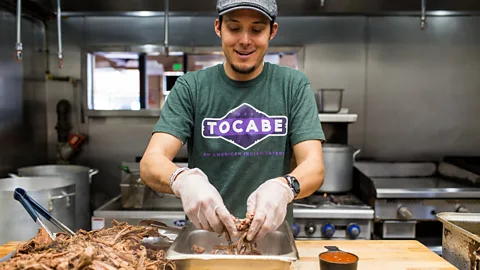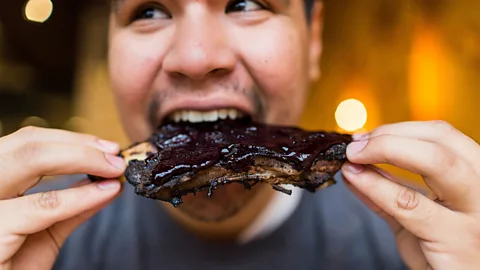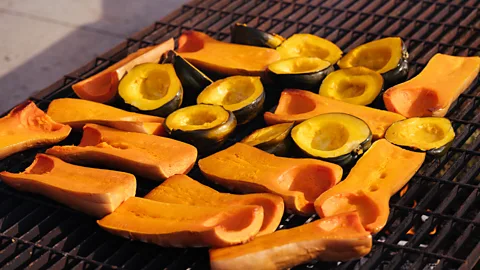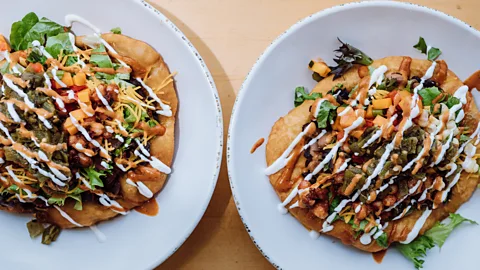Ben Jacobs, one of the US's premier Native chefs, explains how to make a celebratory feast that tells "a story of people and place".
Ben Jacobs is on a mission. The Denver, Colorado-based chef and entrepreneur wants to make Native foods more accessible to the public and educate people about Indigenous culinary traditions across the United States. To do this, he's opened the Native American restaurant Tocabe; a meal-delivery service called Harvest Meals featuring Native recipes; and the e-commerce site Tocabe Indigenous Marketplace, which connects Native American food suppliers with customers around the country.
As a result, Jacobs is a driving force in a nationwide movement to reclaim Native cuisine. Sixteen years after Tocabe's opening, he's opening an additional location in Denver's Airport in 2025 and the thriving Marketplace donates thousands of meals to communities in need each month. In 2023, Jacobs was also appointed to President Biden's Council on Sports, Food and Nutrition, which helps him further amplify Native foods, culture and community by spearheading programmes like the recent One Lacrosse Gathering on the National Mall.
"With over 570 federally-recognised [Native] tribes – and more that are not federally recognised [by the US government] – there is a massive population of people we are fortunate to represent and help to share the story of their food," Jacobs tells the BBC. "My origins are in the Osage Nation, but we are all working against a food system that was methodically deconstructed [by the US government for centuries]. There's still a long road ahead, and it's not just [Tocabe's] story – it's all of ours."
 Rachel Greiman
Rachel GreimanAs many families gather this season to celebrate the holidays, we asked Jacobs how he might prepare a feast in his own home that reflects his heritage.
"When I think about creating a celebratory feast," Jacobs says, "I go beyond Osage-specific ingredients and traditions because I want people to see that all different Native elements are a part of it."
For Osage Nation members and many other Native American tribes, holiday and celebratory meals are communal affairs, served family style, with everything laid out in the centre of a long table in large bowls.
Jacobs' holiday meal is full of layered flavours – richness from meats, citrus from sumac, tartness from berries, sweetness from honey and maple syrup, freshness from vegetables – and the approach can be modified depending on whether you're in a home kitchen or have access to a smoker or open fire.
 Tocabe
TocabeBison tender steak with a huckleberry glaze
Bison was a staple food in Native American communities for centuries before their systemic eradication. Jacobs explains that the animal's meat was a valuable resource for many communities, including Osage, and supported year-round sustenance. "We select this cut [a petite tender located near the shoulder] due to the tenderness of the meat. Because bison is so lean, you have to be thoughtful with how it is prepared. The tender is exactly that: tender, while remaining juicy and incredibly flavourful. Berries pair really well with bison and wild game meats, and we enjoy the balance," he says.
To prepare the meat, Jacobs recommends rubbing dried sage, salt and pepper into the steak and searing it on each side until it's medium-rare. "For the glaze, you can use whatever berry is accessible to you, but I like huckleberries. Slowly render the berries down with a touch of honey – you don't want it overly sweetened; you're just balancing the tartness of the berries with the honey. Serve the bison steak sliced with the glaze poured over top," he says.
Duck breast with sumac and honey
"Our [duck breast] recipe was inspired by a former principal chief of the Osage Nation, Sylvester Tinker. In 1956, when my mother was 10 years old, he and his wife gave her a cookbook they'd created that covered many methods of Osage cooking. Consistent with our approach, we added our expression to [it with] citrus notes of the sumac glaze balancing the rich fattiness of the duck," he says.
World's Table
BBC.com's World's Table "smashes the kitchen ceiling" by changing the way the world thinks about food, through the past, present and future.
Jacobs prefers to age the duck breast by air-drying it in a cooler for a minimum of five days. He then sears it in a cast iron pan, skin side down. "For the sumac and honey, I make a tea with indigenous herbs like elderflower, nettle, cherry bark, sunflower and rose hip. Reduce the tea down and add wildflower honey to infuse a deeper floral flavour along with the sumac. Slice and plate the duck breast and lightly glaze with the infused honey."
 Tocabe
TocabeSmoked butternut squash soup
"I like to use honeynut squash, but you can use hubbard, butternut or acorn squash, too," Jacobs says. "For ease, put them in the oven to soften. I'd also soften them first in an oven, but then put them on an open fire with blackjack wood – which you can find on Osage land – to add smoky flavour notes. When the squash is cooked, remove the skin and blend it into a thin puree with a vegetable or chicken stock. We use a corn stock to infuse the corn aroma into the smoky creaminess of the squash. Top it off with toasted pumpkin seeds or sunflower seeds, and a drizzle of pumpkin seed oil."
Tepary bean green chilli salad with charred cactus paddle (nopales)
As Jacobs explains: "The tepary bean doesn't have history in Osage cooking, but it's more [a] part of how we cook now with Tocabe. Some of my favourite ingredients are in this dish and come from Colorado and the Southwest, like the chillies and beans and cactus paddles."
Jacobs loves this dish because of how its unique ingredients pair nicely with one another. Here's how he recommends preparing it: "Roast or open fire char your green and poblano chillies and cactus paddle. Remove the skin from the chillies and dice it all up, along with yellow bell pepper, slightly larger than the tepary bean. Make a light vinaigrette with mostly olive oil and a little bit of acid in there – apple cider vinegar is great – and toss it all together. It depends on the time of year, but add a wild onion or scallion to open everything up."
Green salad with amaranth, shaved squash and a maple vinaigrette
Native American food is very vegetable-forward, and the types vary depending on the season: locally-sourced greens and wild harvested greens in the summer, root vegetables in the winter.
More like this:
• Three Native American dishes to celebrate autumn
"Use whatever dark, leafy greens that you have access to. I like to add amaranth microgreens for flavour and colour notes," Jacobs says. "Using a seasonal [raw, shaved] squash is great on this salad… Make a mild vinaigrette with apple cider vinegar, olive oil and maple syrup, and finish off with some smoked salt. The point of this meal is to balance all the textural components of the richness, the sweetness, freshness and smokiness, and the smoked salt adds that little something to help do that."
 Tocabe
TocabeFry bread
Fry bread (a flour-based dough that's flash-fried or deep fried in oil or lard until it's browned or fluffy) is one of the most recognisable Native foods in the US, but as Jacobs explained, "it's got a conflicting past and even present. It's a food that came out of the reservation relocation era [beginning with the Indian Removal Act of 1830 through the Indian Relocation Act of 1956]. It was created from government commodities that were provided to forcefully relocated communities," Jacobs says. "We as Native peoples are not all the same; we are tribally, culturally, regionally different. But fry bread is the one recipe that is most closely related across communities: everyone has a variation on the recipe, but it does tie us together, so I always embrace it."
As such, Jacobs chooses to include it because of its cultural significance across Native Nations and highlights the traditional Osage style of preparing it: "Cut into small squares [that become] puffy when cooked," he explains.
Grilled bannock bread
Though closely related, Jacobs explains that bannock bread and fry bread contribute to an Indigenous feast in different ways. "Personally, I would have both of these breads on my table because they both serve different purposes. For me, fry bread is for dipping into the butternut squash soup, and the bannock bread is to put my tepary bean salad in."
Bannock bread and fry bread are also prepared in a similar way. "This is made with the same dough as fry bread. Take the dough and grill it on an open fire so it puffs and chars. Then brush it lightly with olive oil and smoked salt."
 Tocabe
TocabeYonkapin
"Yonkapin is a water lily root and is a traditional Osage ingredient," said Jacobs, noting that it used to be foraged in ponds across the Osage Nation. "You would step into the water and would feel around with your feet where to pull it out. It's one of my favourite things to eat and to cook; they're versatile, too. Traditionally, you might just put yonkapin in a soup, but I like to shave it really thin with a mandolin and quick fry it, so it turns into a chip. You can eat them as a side, or you can crumble them on top of the bean salad, or I even like to dip it into the butternut squash soup."
--
If you liked this story, sign up for The Essential List newsletter – a handpicked selection of features, videos and can't-miss news, delivered to your inbox twice a week.


Post a Comment